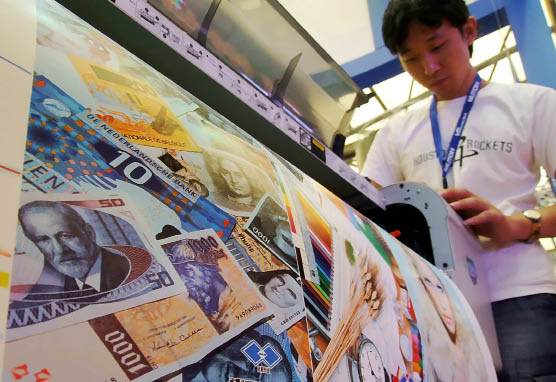Reserve Accumulation not the Culprit of Instability in the International Monetary System
 By HU JIANGYUN
By HU JIANGYUN
The emphasis placed on reserve accumulation as a risk to the international monetary system has led to a loss of clarity in discussing options to reduce such risks.
THE global economy took a nosedive as the financial crisis hit in 2008. The U.S. dollar and the Euro saw their value fall precipitously in world currency markets, triggering worries about the stability of the international monetary system.
Some officials in the developed world put the blame on Asian countries, and on China in particular, for instability in the international monetary system. They contended that excessive reserve accumulation of foreign exchange and gold was the leading cause behind prevailing monetary imbalances. The International Monetary Fund put its weight behind this argument, igniting worldwide debate on the issue.
As the global economy slowly recovered, economists and policymakers began to reconsider the issue of international reserves, in particular the impact that increasingly large reserves in developing countries such as China have had on the international monetary system. Many now acknowledge that the claims that developing countries’ burgeoning reserves exacerbated global monetary instability were erroneous. Backing this reevaluation is a report published last December by the IMF’s Independent Evaluation Office (IEO) entitled “International Reserves: IMF Concerns and Country Perspectives.”
The report is based on the organization’s study of 43 advanced and emerging economies over the 11 years from 2000 to 2011. Its writers used information collected during semi-structured interviews conducted on the basis of questionnaires to facilitate comparability and comprehensiveness. It solicited the views of IMF senior staff, former management, executive board members, current and former senior country officials and policymakers, and representatives from other international organizations, financial markets, think tanks, and academia.
The report concluded that the emphasis placed on reserve accumulation as a risk to the international monetary system has led to a loss of clarity in discussing options to reduce such risks. Moreover, factors other than reserve accumulation – notably the leverage-induced fluctuations in global liquidity, inadequate financial sector regulation, and capital flow volatility – are more pertinent sources of concern about systemic resiliency. It suggests that reserve adequacy indicators should be applied flexibly and reflect country-specific circumstances.
Anchored in solid facts and objective analysis, the report is credible and convincing. On the relationship between reserve accumulation and stability of the global monetary system, it comes to the conclusion that many analysts failed to see the whole picture. Issues overlooked include the root causes of the buildup in some countries’ foreign reserves and the impact of “quantitative easing” policies in the developed world on global financial stability.
Studies reveal that as countries develop they typically aim to grow their currency reserves in order to pay for advanced equipment and technology imports and make overseas investments. Ample reserves are also critical to the countries’ macroeconomic stability and a form of insurance against crisis.
The Asian financial crisis of 1997 showed us what happens when countries with open financial sectors and inadequate international reserves are hit by “hot money” flight. Southeast Asian nations saw massive volumes of foreign capital leave their countries in a short space of time. Because they lacked the reserves, they were unable to buy back currency and limit large depreciations in their currencies.
 |
| Chinese banks have rolled out a variety of foreign currency investment products. |
In 1997 Asian economies learned their lesson. Many started to build up large international reserves in the wake of 1997. When the latest crisis hit, they were cushioned from global monetary shocks and fared much better than countries in other parts of the world.
The IEO report of last December breaks away from earlier IMF studies. The Fund had previously alluded to undervalued currencies and the distorted monetary policies of a number of emerging economies, including China, as the culprits behind world economic imbalance and the recent instability in the international monetary system.
On December 19, 2012 – the day the IEO report was published – the Washington Post ran a story “Auditor Finds IMF Was Pressured by U.S. to Fault China.” It noted that the United States is the fund’s largest shareholder and has an effective veto over major decisions by the IMF board. Focus on foreign reserve accumulation in several early studies by the IMF conflated reserves into the issue of trade imbalances between the U.S. and China, and in doing so steered public attention away from more pressing issues facing the world economy. This raises the suspicion that politics may play a role in the organization’s research conclusions.
Whatever the motivation behind the IMF’s earlier reports, countries’ foreign reserves are in no way the decisive factor in determining the stability of the world monetary system. We must not mistake cause for consequence. As long as the international monetary system operates smoothly and the financial market is effectively regulated, developing countries see no need to stock up foreign reserves.
Calls for such a system are by no means unrealistic. The four “Asian Dragons” – South Korea, Singapore, Hong Kong and Taiwan – prospered without excessive accumulation of international reserves under an effective, well-regulated world financial system in the 1970s. But as the world monetary system began to wobble at the end of the 20th century, developing countries saw no alternative but to stash away greater volumes of foreign currencies to ward off potential crises.
The “quantitative easing” policies of the West, which essentially equate to printing money and triggering inflation to kick-start growth, have undoubtedly had repercussions for global monetary stability. The U.S. is the worst offender – as the Federal Reserve launched a third round of quantitative easing in September last year, Chinese exporters braced themselves for a rise in the value of the RMB and corresponding loss in price competitiveness. Economists also warned that quantitative easing would lead to surges in speculative flows of hot money into developing economies like China’s, with potentially harmful consequences.
Hu Jiangyun is a researcher at the Development Research Center of the State Council.

